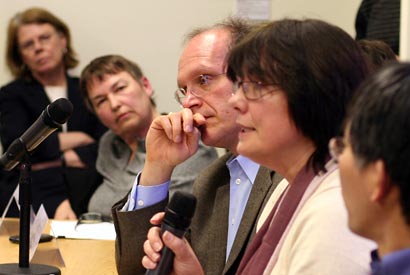Nuclear Experts Say U.S. Safe from Japan Radiation
Radiation from a tsunami-crippled nuclear power plant in Japan does not pose a public safety risk to people outside of the disaster area, UC Berkeley nuclear engineers told an overflow audience of about 100 people at the Institute for East Asian Studies on Wednesday (March 16).
Even with United Nations predictions that a radioactive plume could reach California by Friday, campus experts insisted that any levels of airborne radioactivity would be well within safe limits because radiation doses go down exponentially with distance from the source.

“Is it dangerous here? No. Is it dangerous on the site [of the power plant]? Yes,” said nuclear engineering professor Peter Hosemann, one of six panelists at the roundtable discussion “Japan’s Aftermath: An Initial Assessment of the Nuclear Disaster in Japan.” The event focused on recent events in Japan, with professors, primarily from the College of Engineering, providing context and insights.
“I am not worried about that accident at the nuclear power plant,” said Shinya Nagasaki, a visiting professor at UC Berkeley who is scheduled to return to his position at the University of Tokyo on Tuesday (March 22). “I am worried about the shortage of food and supplies.”
Two of the reactors at the Fukushima Daiichi power plant were severely damaged by the force of a huge tsunami wave propelled by the massive offshore earthquake on March 11. With the ongoing failure of electrical power at the plant, crews of workers and soldiers are using water cannons to keep the reactors from overheating, cracking and releasing their radioactive contents.
The UC Berkeley panel drew an audience that included journalists, members of the campus community and the general public. The crowd, which packed a conference room and adjacent hallways, included people concerned about family members in Japan–and skeptical about information released so far about radiation safety.
“If the Japanese government is lying, we would have heard from North Korea and Russia that they detect radiation,” said Department of Nuclear Engineering Chair Jasmina Vujic, one of the panelists.
Comparisons to the 1986 nuclear disaster at Chernobyl in Russia came up repeatedly. The experts highlighted the many differences between Chernobyl and Fukushima Daiichi, including the decision by the Russian government to wait three days before admitting that there had been a reactor failure.
The panelists said that the Fukushima Daiichi accident highlights the complexity of nuclear power development, and noted that other countries, including China and France, are continuing to construct or operate nuclear power plants.
“We need energy. Every source has risks associated with it,” said panelist Joonhong Ahn, professor of nuclear engineering. “If we do nuclear, we need deep international collaboration and discussion.”
The other panelists were Bozidar Stojadinovic, professor of civil and environmental engineering, and Dana Buntrock, associate professor of architecture. The moderator was Cathryn Carson, professor of history and associate dean of social sciences.
The event was sponsored by the Institute of East Asian Studies, the Science, Technology and Society Center, the Center for International Studies, the Center for Japanese Studies, and the departments of nuclear engineering, civil and environmental engineering, and architecture.
